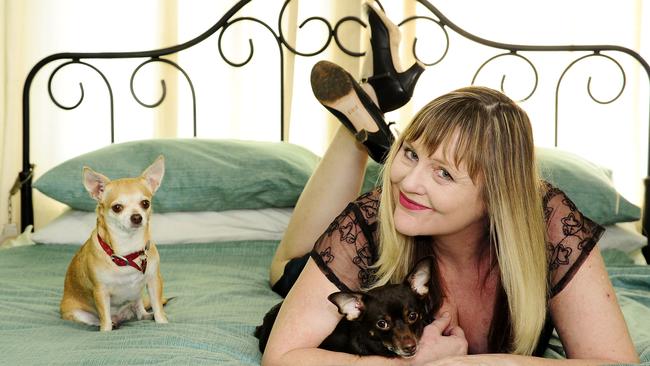Mandy’s Sayer’s Misfits and Me: cast of ferals with heart
It’s hard to think of an Australian better equipped to write about misfits than Mandy Sayer, a square peg in human form.

On the evidence of Misfits and Me, an assemblage of nonfiction pieces written across two decades, the Australian misfit is a very different figure to the English eccentric. There is more potential for violence when it comes to the local version, whether inflicted by others or emanating directly from the individual.
They are likelier to come from the underclass than the upper-middle, likelier to have been damaged by some brute structural fact of antipodean society than perform their oddity while nestled comfortably within it.
Ferals, then. Convicts and bushrangers in the wrong time and place. Except that the oddballs explored by Mandy Sayer in these pages, which range across a number of years and many parts of the country, can also be gentle and caring. Those who have been bent out of shape by the world are best placed to acknowledge that brokenness in others and seek to heal them.
Take Tony Bowers, the Aboriginal elder who, having spent a long, painful period recovering from a serious motorcycle accident, travels the country in a specially designed van, dispensing tinctures of cannabis to sufferers of multiple sclerosis or those undergoing chemotherapy, all the while at risk of criminal charges.
Or the residents of a block of flats in Sydney’s eastern suburbs, given over to social welfare housing. These hardscrabble egalitarians have banded together to ensure mutual security, three square meals a week for the ill and elderly of the building, and a collective booze and fags policy for all.
Or even the sweet, strange, harmless obsessiveness of Sayers’s cousins — a brother and sister who live together in their family home, perched on top of two generations of hoarded objects.
This unpatronising gentleness is certainly true of the collection’s author. It’s hard to think of an Australian author better equipped to write about misfits than Sayer. She is a square peg in human form.
Her early years were spent on the run from an abusive stepfather. (One piece here explores “Elsie”, Australia’s first women’s shelter, founded in Sydney’s inner west in the 1970s by feminist and writer Anne Summers, where the 11-year-old Sayers found herself living for a time.) A wild teenage period followed, when the author lived in Melbourne in the company of her alcoholic mother.
Then there were those extraordinary times spent working as a street performer in America with her musician father, all of which has been recorded with grace, humour and a remarkable absence of self-pity in a series of award-winning memoirs.
The second section of Misfits is devoted to essays which expand upon or provide footnotes to those longer works.
Central among them is a piece given over to an account of the origins and nature of her marriage to novelist and playwright Louis Nowra. They met in the late 1990s, when the pair decided to assemble an anthology of writing from and about Sydney’s Kings Cross, an area where they both lived at the time. Their initially platonic relationship deepened as Sayer’s father, Gerry, fell deeper into illness. After his death from cancer, the pair found flats beside one another and began a together-but-apart existence that suited their respective foibles. After marrying in 2003, the couple briefly explored the possibility of living together:
But after one long, objective look at Louis’s apartment, stuffed with Chihuahua tea towels, mugs, statues and calendars; shelves and books on the porn star Christie Canyon, another set of shelves devoted to tomes on the history of mushrooms; his CD collection filled with the names of bands I could hardly pronounce, I wasn’t sure it was a good idea.
Sayer is at her best when exploring the oddities of her nearest and dearest, and Nowra, a ferociously independent and determined writer, gets the gong for pure eccentricity. That said, he is up against some serious competition.
Sayer’s brother takes twice-daily breaks from his work as a housepainter to give himself dialysis in the back of his vehicle.
Meanwhile, Sayer’s mother flirts with her daughter’s prospective husband while warning him away from Mandy. The reason — “she’s very promiscuous”. Meanwhile, the dying Gerry Sayer’s last words are: “There’s not nearly enough f..king in the world!”
Misfit artists and writers are the subject of the final portion of the book, and these essays range across a whole spectrum of creative weirdness. There is a blow-by-blow account of Victorian artists: John Brack’s portrait of Edna Everage, for example. Brack was a painter so averse to the trappings of fame that, when his works finally started selling in the 1980s, he became panicked at the thought of success. “Oh, this is hideous, this is horrible!” Brack would cry as he worked the canvas with Edna in pearls before him. “That’s good,” Humphries would reply, “keep at it.”
A trip to Thea Astley’s house on the NSW south coast in the mid-90s is a joy for the glimpse it gives into that brisk and passionate author, a woman whose idiosyncrasies included refusing to have photographs of her taken in profile.
It is perhaps not so strange that the collection ends with a piece written only months ago, for this newspaper, about Shaun Prescott, a man at the vanguard of a new generation of authors with inveterately local subject matter but universal ambitions.
Prescott grew up in central-western NSW and his bizarre debut novel, The Town, explores the physical disappearance of a town not unlike Bathurst, where the 33-year-old came to study at university.
Sayers approves of Prescott’s refusal to take early success too seriously (the book was sold into multiple territories at last year’s Frankfurt Book Fair), and his writing regime (at night, after his young daughter has gone to bed, in the covered outdoor area of a Blue Mountains cottage, using a battered cake tin as an ashtray).
In her dippy 1933 monograph on the subject of eccentricity, Edith Sitwell wrote “it is not, as dull people would have us believe, a form of madness. It is often a kind of innocent pride, and the man of genius and the aristocrat are frequently regarded as eccentrics because genius and aristocrat are entirely unafraid of and uninfluenced by the opinions and vagaries of the crowd.”
On the basis of Sayer’s local survey, the Australian misfit is equally unmoved by what everyone else thinks, though for reasons that have everything to do with powerlessness, not the exercise of a privilege so long inborn as to have become warped.
There is less chilly wit in these pages than in Sitwell’s book. But there is far more heart.
Geordie Williamson is The Australian’s chief literary critic.
Misfits and Me: Collected Nonfiction
By Mandy Sayer
NewSouth, 256pp, $34.99


To join the conversation, please log in. Don't have an account? Register
Join the conversation, you are commenting as Logout